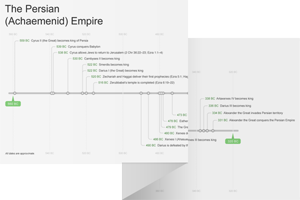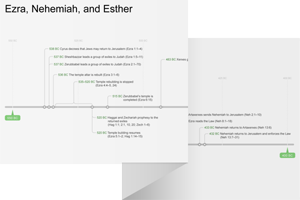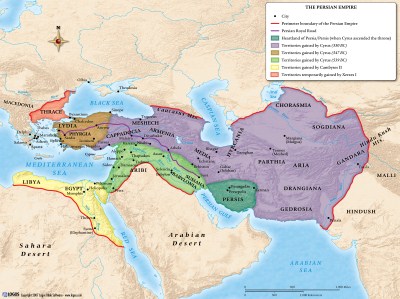1:1–9 The events in the book of Esther |
1:1 in the days of A traditional formula used in Hebrew narratives (e.g., Josh 1:1; Judg 1:1; Ruth 1:1; 1 Sam 1:1; 2 Sam 1:1; Ezek 1:1; Jonah 1:1).
Ahasuerus This Persian king was called Ahasuerus in Hebrew but is better known by his Greek name, Xerxes.
The Persian king Ahasuerus At this point, Xerxes was a successful military ruler who ended rebellions in both Egypt and Babylon (around 484 bc) prior to the time of the book of Esther. These events may explain Xerxes’ celebration of his reign in this chapter of Esther. |
Date | Event |
Cyrus allows Jews to return to Jerusalem | 538 bc |
Temple is completed | 516 bc |
Xerxes becomes king | 486 bc |
one hundred and twenty-seven provinces Each province had its own governor (see Esth 3:12) who was responsible for collecting the tribute owed to the king and raising the armies needed to defend and expand the empire.
1:2 Susa Located on the Shaur River, about 150 miles north of the Persian Gulf. The city became part of the Persian Empire when Cyrus took Babylon and its provinces. Darius I made Susa (also called Shushan) an administrative capital and built a palace in the city. See note on Ezra 4:9.
citadel of The Hebrew word here refers to a fortified area above the rest of the city. The palace portion of the city during this period was built upon a tell (a hill partially created by human efforts); it is a portion of this area, or perhaps the entire area, that is referenced in Esther 1:5.
1:3 third year of his reign Probably sometime in 483 bc.
a banquet The Hebrew word used here occurs 20 times throughout the book; the book is full of elaborate parties (2:18; 5:4; 7:2; 9:18–19, 20–22).
The army of Although the Hebrew only uses the word chayil (“army”), the context implies that this refers specifically to the military leaders, not the entire army.
Persia and Media These two nations originally allied in an effort to overthrow the Babylonians. During the early years of the alliance, Media was the dominant force. However, with Cyrus’ rise to power in 559 bc, the seat of power shifted to the Persians.
was the dominant force. However, with Cyrus’ rise to power in 559 bc, the seat of power shifted to the Persians.
1:4 one hundred and eighty days The party lasts for six months. While the Persians were known for extravagant celebrations, the excessive length may be an exaggeration either for comedic effect or to critique the Persians’ licentious lifestyle. The length of the banquet, the roster of invitees, and the king’s decision to display his wealth suggests this may have been the military planning session for Persia’s invasion of Greece, which took place from 480–479 bc.
1:5 all the people that were present at the citadel of Susa It is difficult to determine how many people would have attended such a banquet, but the intention of the narrative is to indicate the king’s vast wealth and lavishness—for seven straight days, he feeds and provides wine for the general populace living closest to him, without regard for their social standing.
1:6 curtains of finely woven linen and blue cloth The royal colors of Persia were used.
couches of gold and silver The Persians routinely reclined on couches while eating.
1:8 no restrictions on The Medes and Persians had a law that whenever the king drank, everyone drank. This phrase may refer to the temporary negation of this law or to each person being allowed to drink however much he desired.
1:9 Queen Vashti Although connections at times have been made between Vashti and the Persian queen Amestris, such connections are inconclusive. Vashti is known only from the book of Esther.
and the Persian queen Amestris, such connections are inconclusive. Vashti is known only from the book of Esther.
gave a banquet for the women Persian meals often involved both men and women, so either the queen or king make an intentional decision to have the women attend a separate banquet—perhaps due to the amount of guests attending. This detail sets the stage for the king’s later decisions at his own all-male party.
1:10–22 While intoxicated, the king requests his queen come to his banquet of all men (vv. 10–11), forcing her to leave her own banquet guests (v. 9). It is this narrative, full of ludicrous decisions, that sets up the events of the rest of the book. |
1:10 the heart of the king was merry with wine The reference to the king’s intoxication foreshadows a forthcoming poor decision (compare Dan 5:2). The text is reminiscent of Judg 16:25, where the drunken Philistine lords call for Samson to be brought before them. The book of Proverbs frequently comments on the inability of drunkards to make wise decisions (e.g., Prov 20:1; 21:17; 31:4–5).
eunuchs Male servants or supervisory royal officials; this context implies that these men are also castrated.
1:11 show the people and the officials her beauty The king may have viewed public exhibition of the beautiful queen as part of the presentation of the glory and splendor of his reign (Esth 1:4).
royal crown In Persian culture, this would have been an especially adorned turban.
1:12 Queen Vashti refused to come The reason for the queen’s refusal is unknown. Although the king’s request was likely unreasonable, her refusal to obey the king’s command was understood as a serious breach of court etiquette—because it was still the demand of the king, whom everyone was required to obey.
1:13–15 The syntax of the Hebrew text in this section is ambiguous. There may be two groups of people being consulted here (astrologers and the highest-ranking government officials) or only one group (the officials). Either way, it is clear that the king decides not to make the decision about how to respond to Vashti on his own; instead, he appeals to advisors—an act the narrative describes as procedure (vv. 13–15). It is also clear that the seven men mentioned directly have special access to the king; they likely represented the seven noble families of the empire. |
1:13 the ones who know the times This Hebrew phrase could either mean that these advisors were experts in astrology or that they were knowledgeable in the affairs of the empire and how the king’s decisions would affect the people (compare 3:7; Dan 2:27; 1 Chr 12:32).
1:18 the women of nobility The king’s advisor, Memucan, is particularly concerned about the possible response of the wives of the royal advisors—those who would have overheard Vashti’s refusal at the women’s banquet. Memucan’s concern is likely that the wives will refuse to obey the words of their husbands like Vashti has—that they would defy the expectations of their patriarchal culture by disobeying their husbands (compare Esther 1:22).
1:19 let it be written The written word is a common motif in the book of Esther (vv. 19; 3:12; 8:9; 9:14, 20–21, 29–32; 10:2).
it will not be altered Persian decrees could not be repealed once they became official (see Dan 6:8).
before King Ahasuerus Access to the king’s presence meant the ability to both influence the king and secure favors. Vashti is deposed, not killed, but her influence is essentially nullified.
1:20 all the women will honor their husbands This is the primary reason cited by the book of Esther for the king’s decision to depose Vashti. Since the king is at a public banquet of all men—in a patriarchal society—there is immense social pressure for him to correct his queen’s perceived disobedience. The king’s advisor, Memucan, indicates here and in Esther 1:19 that the fear is that Vashti’s behavior will become an example among those of the nobility class and then move to other social classes.
1:22 he sent letters Fifth-century bc Greek historian Herodotus notes that the Persians were able to transmit letters quickly across the empire by using a relay method for their horseback riders—using a new horseback rider and horse each day of the journey (Histories 8.98).
who speaks in the language of his people This phrase in the Hebrew text is ambiguous. This statement may be understood as emphasizing that the king’s request be sent out in multiple languages or that it be deployed not just in the various languages of the empire but also in variant scripts.

|
About Faithlife Study BibleFaithlife Study Bible (FSB) is your guide to the ancient world of the Old and New Testaments, with study notes and articles that draw from a wide range of academic research. FSB helps you learn how to think about interpretation methods and issues so that you can gain a deeper understanding of the text. |
| Copyright |
Copyright 2012 Logos Bible Software. |
| Support Info | fsb |
 Loading…
Loading…

 Ahasuerus
Ahasuerus 


